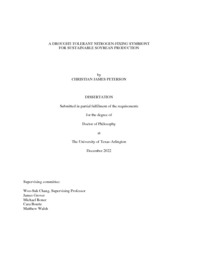
ATTENTION: The works hosted here are being migrated to a new repository that will consolidate resources, improve discoverability, and better show UTA's research impact on the global community. We will update authors as the migration progresses. Please see MavMatrix for more information.
Show simple item record
| dc.contributor.advisor | Chang, Woo-Suk | |
| dc.creator | Peterson, Christian James | |
| dc.date.accessioned | 2023-01-26T16:15:57Z | |
| dc.date.available | 2023-01-26T16:15:57Z | |
| dc.date.created | 2022-12 | |
| dc.date.issued | 2023-01-02 | |
| dc.date.submitted | December 2022 | |
| dc.identifier.uri | http://hdl.handle.net/10106/31053 | |
| dc.description.abstract | Bradyrhizobia are an ideal model organism to study plant-microbe interactions due to dual lifestyles as free-living soil organisms and as endosymbionts for valuable cropping systems in agriculture. Farmers have been utilizing the Soybean-Bradyrhizobium japonicum mutualism for decades to revitalize marginal soils, increase yields, and establish a regenerative approach to farming by mitigating the use of synthetic nitrogenous fertilizers. The largest impediment to bio-fertilizer success is desiccation (e.g., drought) stress before the symbiosis can be established. Due to climate change, fluctuating high temperatures and drought occur seasonally in many growing regions and are becoming a growing concern for modern agriculture. Thus, alternative methods must be presented to farmers to enable sustainable production despite such abiotic extremes. To this end, we have bio-prospected drought-tolerant Bradyrhizobia from the root nodules of soybeans in south Texas and formulated an inoculant for farmers in drought prone regions. Field trials were conducted in the Mid-South for 3 years using the drought-tolerant inoculant B. japonicum TXVA and a non-inoculated control. The drought-tolerant inoculant dominated taproot and total root nodulation and imparted a 7% total grain yield across locations and years. In addition to drought field trials, we were given the opportunity to test the TXVA inoculant under heat stress using a novel temperature gradient greenhouse developed by Dr. Kent Burkey from the USDA in North Carolina. Lastly, whole genomes of two Texas native drought-tolerant isolates (i.e., B. japonicum TXVA & TXEA) were sequenced and the comparative genome analysis was performed among the Texas isolates, B. japonicum USDA 6 and SEMIA 5079. Phylogeny revealed similarities between the native strains and type strain USDA 6 which has been used as an inoculant. Our research allows for further understanding the application, function, and molecular characterization regarding biofertilizers to aid sustainable soybean production in the face of a changing climate. | |
| dc.format.mimetype | application/pdf | |
| dc.language.iso | en_US | |
| dc.subject | Microbial inoculants | |
| dc.subject | Biofertilizers | |
| dc.subject | Environmental microbiology | |
| dc.subject | Climate-smart farming | |
| dc.subject | Drought stress | |
| dc.subject | Heat stress | |
| dc.subject | Soybean | |
| dc.subject | Drought-tolerant | |
| dc.title | A DROUGHT-TOLERANT NITROGEN-FIXING SYMBIONT FOR SUSTAINABLE SOYBEAN PRODUCTION | |
| dc.type | Thesis | |
| dc.date.updated | 2023-01-26T16:15:58Z | |
| thesis.degree.department | Biology | |
| thesis.degree.grantor | The University of Texas at Arlington | |
| thesis.degree.level | Doctoral | |
| thesis.degree.name | Doctor of Philosophy in Quantative Biology | |
| dc.type.material | text | |
| dc.creator.orcid | 0000-0002-6659-6578 | |
Files in this item
- Name:
- PETERSON-DISSERTATION-2022.pdf
- Size:
- 2.548Mb
- Format:
- PDF
- Name:
- Dissertation_CP_Final_1.docx
- Size:
- 9.414Mb
- Format:
- Microsoft Word 2007
- Name:
- Dissertation_CP_Final.docx
- Size:
- 9.414Mb
- Format:
- Microsoft Word 2007
- Name:
- Dissertation_Peterson_final.docx
- Size:
- 9.406Mb
- Format:
- Microsoft Word 2007
This item appears in the following Collection(s)
Show simple item record


